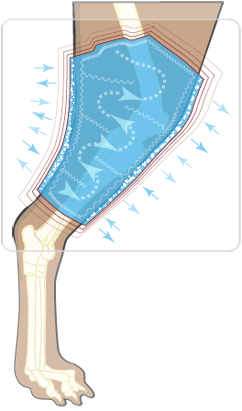Laurie's Blogs.
Jul 2019
Icing after a knee surgery

This is going to be an easy blog for me. Honestly, I’m just going to redirect and cut and paste from elsewhere. Here we go!
So, in December of 2018, Game Ready, a company that manufactures and distributes continuous passive cooling & compression devices, discontinued their canine line. Many folks were dismayed. The company put a letter up on their website that you can read at:
http://www.gamereadycanine.com/Game-Ready-Canine-Discontinuation-Letter.pdf
They’re still making their human and equine line… just not the canine product line. Should you be worried? Many were! Were you thinking you might purchase one and that it would make all the difference? Many thought so!
One canine paper showed that it did help with pain, lameness, and swelling in dogs following TPLO surgery. https://pdfs.semanticscholar.org/9872/c445ff1df96f8ccd7d2ac4427ffb13253289.pdf
However, I want to highlight a ‘human’ paper that studied the difference between standard periodic icing protocols and use of a continuous cold therapy compression device. Instead of linking to the abstract, I think this synopsis gives the best overview of the information:
And, as cheeky as I am, I’m going to cut and paste it here for you (but notice that I referenced the original source… so, it’s all good)!
“Frontline physiotherapists frequently reflect on their clinical practice and query what is ‘best practice’ for a specific patient or patient population. Sometimes the answer is found in the literature; sometimes it isn’t. At the end of 2007, an interdisciplinary clinical team (physiotherapist, occupational therapist and nurse) at St. Paul’s Hospital in Vancouver, BC, noted that some of the orthopaedic surgeons on their ward were starting to recommend continuous cold therapy compression devices for patients following Total Knee Arthroplasty (TKA). Patients and staff began asking the question “Which is best: device or ice?” A literature search in 2008 didn’t provide the answer. Consequently, the team decided to pursue the answer, but given that they had limited research training and experience, requested guidance from Alison Hoens (Physical Therapy Knowledge Broker and the Research, Education and Practice Coordinator for Physiotherapy at Providence Health Care). Undaunted by the absence of research funding, training and experience, the team embarked on a randomized control trial to address the question of whether consistent cooling using a device was more effective than intermittent cooling using an ice bag for 48 hours after TKA on influencing pain, range of motion, nausea/vomiting, blood loss and leg function.
The intervention group had the DonJoy IceMan™ applied immediately post-operatively but was removed after the first hour of application and then every four hours thereafter to allow for the standardized nursing assessment to detect potential skin and nerve damage: The control group received cooling using an ice bag, at a frequency requested by the patient. The workflow ‘workarounds’ reflected the reality of research in a busy clinical setting.
The analysis revealed that there was no significant difference in the primary outcome or in secondary outcomes of passive range of motion, nausea/vomiting, opioid use, blood loss, length of stay or function at 6 weeks between the device and ice groups. However, the device group was significantly more satisfied, used the device more consistently day and night and was more likely to recommend this method of cooling.
The most important outcome of this project was that the results were used to direct clinical practice. Administrators and clinicians are now confident that given the increasing demands on shorter length of stays for most procedures, the extra costs and resources (time to refill and reapply) the cooling devices are not necessary for better patient outcomes following TKA. The choice on whether to use a cooling device or ice in a bag resides with the patient.”
So, don’t despair about the absence of the Game Ready device in canine medicine. Use ice packs therapeutically in hospital and instruct owners on administering them at home as well, and you’ll be all set!


